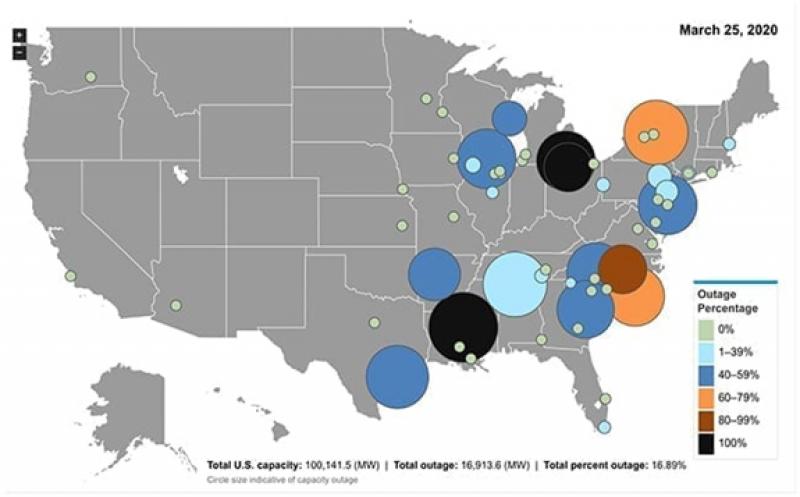Challenged by the COVID-19 pandemic, the U.S. nuclear industry has asked the Trump administration to ensure nuclear workers, suppliers, and vendors will have access to nuclear plants and personal protective equipment (PPE) during the 2020 spring and fall refueling outage seasons and beyond.
In a March 20 letter to Energy Secretary Dan Brouillette, Nuclear Energy Institute (NEI) President and CEO Maria Korsnick noted nuclear reactors have a “unique requirement” to load a fresh batch of fuel once every 18 to 24 months. The event necessitates a shut down for two to four weeks during which intense work occurs, including critical maintenance.
“Each plant typically brings in several hundred specialized workers for this work over a typical period of 30-60 days, which includes activities in advance of and following the outage. These workers typically stay in hotels or board with local families, and eat in restaurants,” Korsnick wrote. In the course of performing outages and in routine operations, nuclear plant workers also use PPE and supplies for radiological protection. As the COVID-19 pandemic intensifies, the industry will also require medical PPE and supplies to minimize its spread, she said.
Planned Nuclear Refueling Outages in 2020
In 2020, 56 of the nation’s 58 nuclear reactors in 21 states—including several that have issued lockdown measures—planned to undergo refueling outages. At least 31 of the 58 plants had scheduled outages between mid-February and early May. The remaining 25 planned refueling outages between late August and late October. While the average U.S. refueling outage times have shortened in recent years—decreasing from an average of 46 days in 2012 to 32 days in 2019—the 2020 season was poised to be especially busy in part because planned nuclear generation outages are generally timed to coincide with a plant’s refueling cycle.
As of March 25, according to the Nuclear Regulatory Commission (NRC), 13 of the U.S.’s 96 commercial nuclear reactors were offline for refueling outages: Indian Point 3, Nine Mile Point 1, Susquehanna 2, Browns Ferry 2, Brunswick 2, McGuire 1, North Anna 2, Turkey Point 4, Vogtle 2, D.C. Cook 1, Perry 1, Point Beach 1, and Quad Cities 1. At least five others were coasting down in preparation for refueling outages: Limerick 2, Salem 1, Byron 2, Monticello, and Comanche Peak 1. The Energy Information Administration (EIA), which compiles data from the NRC into a useful interactive map that shows the status of U.S. nuclear outages, noted that 16.9% of total U.S. nuclear capacity—about 100 GW—was offline as of March 25.

A Compounding Crisis
The NEI said that across the nuclear fleet precautions are being taken to limit the risks of COVID-19. Among the actions are:
Directing employees who don’t feel well to stay home, encouraging them to seek medical attention, and asking for a report on their condition;
Excluding personnel who have recently been in countries impacted by the virus;
Screening of employees, contractors, and any necessary visitors at the plant gate and, at some
plants, taking their temperature;
Disinfecting surfaces more often;
Closing or limiting access to cafeterias and other places employees congregate; and
Increasing the number of hand-washing facilities.
Because refueling outages are so critical to the safe and reliable operations of nuclear power plants, the Trump administration should consider several actions that would immediately benefit nuclear owners, operators, and vendors, Korsnick said.
For one, she urged Brouillette to ensure that federal designation of essential workers include workers that support nuclear operations. The Trump administration’s March 19–issued initial list of “essential critical infrastructure workers” broadly includes “workers needed for safe and secure operations at nuclear generation,” but it does not specify whether the extensive list of specialized contract workers needed for outage work are qualified.
Korsnick also urged the administration to allow “unfettered” travel to plants for the performance of essential outage activities. Noting that the workforce is sometimes sourced abroad, she also asked it to “permit international workers who perform highly specialized functions to travel into the U.S. and establish protocols immediately to enable their safe entry.”
To accommodate workers, she also urged the administration to keep open hotel and food services. Finally, she asked for priority for PPE, specifically asking for surgeons’ gloves, sanitized wipes, dust masks, and disposable thermometers—as well as COVID-19 testing kits, and necessary radiological and medical protective equipment and supplies for nuclear workers.